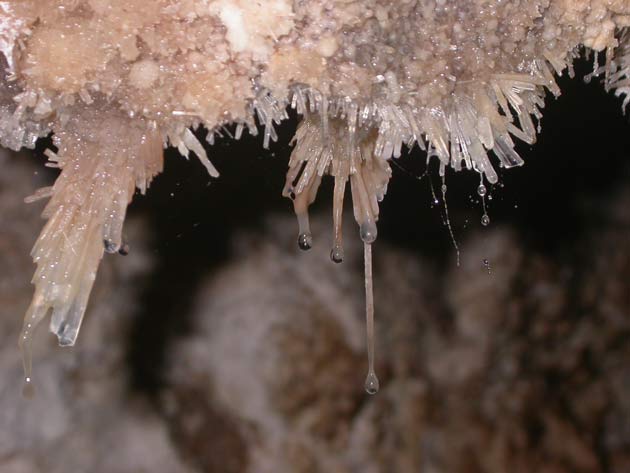Snot-Like Microbes Help Carve Caves

SAN FRANCISCO—Cave-dwelling bacteria are interior designers of sorts, forming mucus-like chandeliers that hang from cave ceilings and coat the floors with thick mats. Now scientists are finding the tiny critters can also help turn a meager underground residence into an ever-expanding dark palace.
By rappelling into the Frasassi cave system in Italy, for the first time, scientists have revealed clearly the role of cave bacteria [image] in actually forming caves, as reported this week here at the meeting of the American Geophysical Union.
"We really are able to implicate microorganisms in speeding up cave formation," said Jennifer Macalady of Pennsylvania State University.
Cave makers
Here's how the cave-forming story goes, without any bacteria:
As oxygen-rich rainwater seeps below the ground's surface it mixes with water that's been sealed off from the air above and is full of hydrogen sulfide—the stuff known for its rotten-egg smell. The oxygen turns this hydrogen sulfide into sulfuric acid, which begins dissolving surrounding rocks. Over time, this acid carves out big chunks of limestone rocks to form and expand cave systems.
Add so-called biofilms, or layers of sulfur-consuming bacteria, to the mix and the story gets more complex. Within just about a millimeter, multiple layers of microbes reside, each tucked into its own niche. The outer layer comprises microbes that thrive by transforming oxygen and hydrogen sulfide into energy. But oxygen can be lethal to some of these tiny bugs, which instead retreat beneath the top layer, sealing them off from oxygen. These layers can convert the sulfuric acid to hydrogen sulfide, creating a complete sulfur cycle along a cave wall or floor.
Get the world’s most fascinating discoveries delivered straight to your inbox.
Just like you would devour a brownie or other snack for sustenance, some cave bacteria consume hydrogen sulfide—the rotten-egg chemical. Whereas your waste product is carbon dioxide, the cave microbes release sulfuric acid.
"One type of biofilm, called a snottite because of its appearance, has a pH of zero or one," said one of the researchers Daniel Jones, also of Penn State. "This is very, very acidic."
Dirty work
One reason the team was able to discover this phenomenon is "partly because we are crazy enough to rappel down into these stinky places," Macalady told LiveScience.
The scientist spelunkers, Macalady, Jones and Greg Druschel of the University of Vermont, measured chemical reactions in millimeter-thick layers of the walls and floors as well as in the streams [image]. They found that the microbes on the floors and in streams consumed loads of hydrogen sulfide, which ended up as caustic acid that washed down the stream to dissolve any limestone it contacted.
"Stream biofilms are responsible for the majority of sulfide disappearance in streams," Jones said.
The findings could shed light on other biofilms, including those that grow on teeth and those that corrode steel ships hulls, suggest the scientists.
Cave-dwelling snottites have also been studied as the sort of organisms that might thrive under the surface of Mars, where water is known to exist.
Jeanna Bryner is managing editor of Scientific American. Previously she was editor in chief of Live Science and, prior to that, an editor at Scholastic's Science World magazine. Bryner has an English degree from Salisbury University, a master's degree in biogeochemistry and environmental sciences from the University of Maryland and a graduate science journalism degree from New York University. She has worked as a biologist in Florida, where she monitored wetlands and did field surveys for endangered species, including the gorgeous Florida Scrub Jay. She also received an ocean sciences journalism fellowship from the Woods Hole Oceanographic Institution. She is a firm believer that science is for everyone and that just about everything can be viewed through the lens of science.
